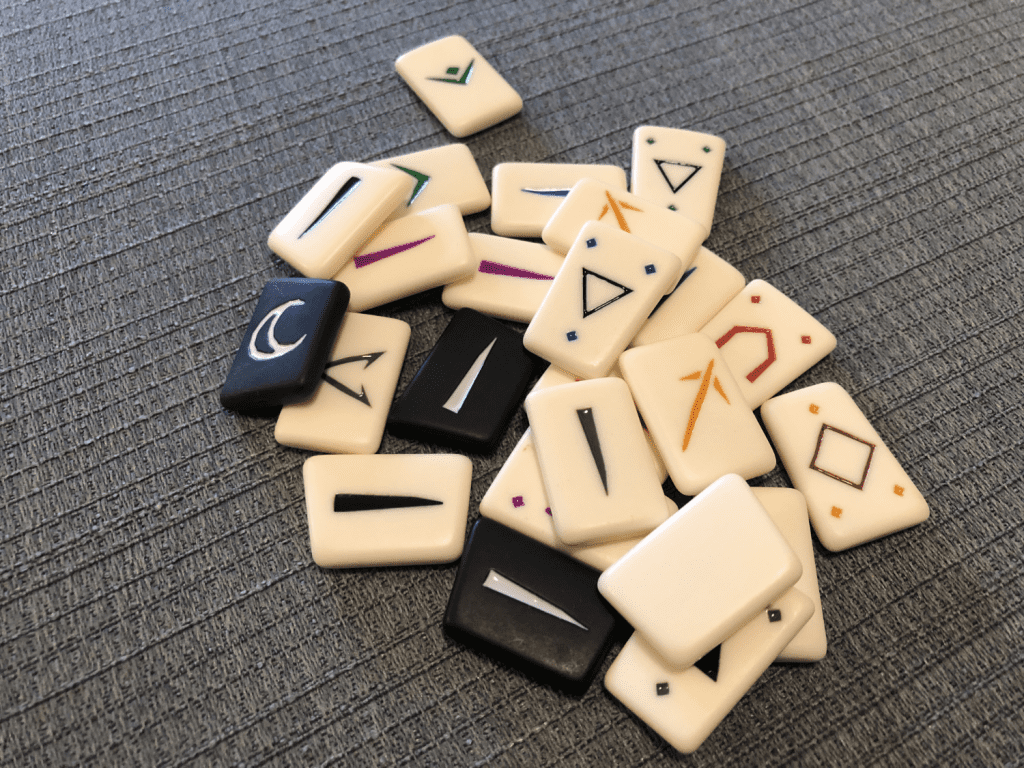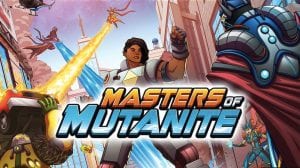Call to Adventure is a 1-4 player game where each player will craft a character by either gaining abilities and going on adventures. Once a player has placed their third card under their Destiny card the round will finish and players add up their points. Whoever has the most points wins.
You can also check out our video review of Call to Adventure and its expansion, Name of the Wind.
Preparing for Adventure
There are 8 different decks of cards to shuffle to get the game started (you’ll also shuffle an additional deck if playing solo or coop). Shuffle the Origin, Motivation, and Destiny card decks separately and give 2 cards from each deck to every player. The players will choose one card from each set and discard the other. After each player has selected their cards they will reveal their Origin and Motivation cards by placing them faceup on their player boards. Their Destiny card will remain face down until the end of the game, but players are allowed to look at their own Destiny card at any time.
Then shuffle the 3 story card decks (labeled with a I, II, or III to indicate which Act the deck represents) and place them in the center of the table where everyone can see them. For a 2-3 player game lay out 4 cards per Act. In a 4 player game lay out 5 cards per Act. Act II and III will be laid out face down and Act I will be laid down faceup.

Shuffle the Antihero (dark blue) and the Hero (light blue) cards and place them to the side of the story card decks. Give each player a Hero card and 3 experience tokens. Each player should also place the corruption marker on the 3rd space from the top on the Corruption track of their player board (left side of the board).
Place the Rune stones where they are easily accessible to every player. The Runes represent traits that players will gather via Trait cards to help them during challenges, and will be used collectively by all players during the game.
The player who most recently read a novel goes first and you are ready to start!
Game Play
On a player’s turn they can take one of two actions.
Gain a Trait is simple – take a trait card from one of the face up Act cards and tuck it under the appropriate areas on your player board – Origin, Motivation, or Destiny card. Each player can only have 3 cards under their Origin, Motivation, or Destiny card. Once a player has 3 cards under their Origin card they can then add cards under their Motivation card, and once they have 3 cards under their Motivation card they can then add cards under their Destiny card. Do not reveal your Destiny card until the end of the game. Some Trait cards require you to have specific traits before acquiring them so make sure to read the text to see how to acquire it.
Attempt a Challenge requires the player to cast rune stones to try and get a specific result. Once they have chosen the challenge they will look at the difficulty of that challenge as indicated by the number on the left-hand side of the card. This number indicates the number of successes the player needs in order to complete the challenge. The player will then indicate which path of the challenge they wish to perform by selecting either the top or bottom path.

After gathering all of the runes they’ve collected, they cast them and count any successes. If the number of successes is greater than or equal to the difficulty of the challenge they gain the Challenge card and tuck it under the appropriate card on their player board. If a rune stone indicates a double triangle (this is on one of the basic runes) the player can draw either a Hero or Antihero card making sure to check which card they can draw based on where they are on the Corruption track.
If a player fails a challenge, discard it from the table and the player receives an Experience token.
Outside of Gain a Trait or Attempt a Challenge, players can also spend 1 Experience token to discard a card from the table, use another card effect, or play a Hero or Antihero card.
After a players turn is over draw a new card from the appropriate story card deck and replace the one that was taken.
The first person to tuck 3 cards under their Origin card will, on their next turn, reveal the facedown cards next to Act II. The same goes for the first person to tuck 3 cards under their Motivation card – they will, on their next turn, reveal the facedown cards in the Act III deck. Once someone has placed 3 cards under their Destiny card the game will end at the end of that round.

End of Game
All players will reveal their Destiny card and tally their points. Players receive points from Trait and Challenge cards, 1 point for each Hero or Antihero card played during the game, Experience tokens, and where they are on the Corruption track.
Another way players earn points is by collecting story icons. Trait and Challenge cards may have different story icons and if a player has collected a certain number of the same kind by the end of the game will get additional points. A set of 2 matching story icons is 2 points, a set of 3 matching is 4 points, and a set of 4 or more is 8 points.
Players count up all their points and whoever has the most points wins.

Components
The artwork and quality of the components is great! The runes are nice and sturdy and the design is etched into the surface so there won’t be an issue with the artwork coming off. The cards are tarot sized, and need to be because of the amount of content. It may not seem like there is a lot of content but a normal size card would look too busy, plus you would not see the beautiful artwork. The illustrations on the cards and the box cover are gorgeous! This game will definitely stand out and grab people’s attention.
The player boards are a good sturdy cardboard. In the copy I received the player boards did have a slight bend in them but it did not affect game play. The player board also has a brief description for the different rune faces so you didn’t have to constantly be looking through the rule book to figure out what each meant. One grief with the components was the Corruption track marker – it was just too big for the track itself and easily moved around. It was of a nice sturdy material similar to the runes, but was just a little too big.
As I mentioned before, the artwork is absolutely gorgeous, but one thing to point out is the diversity within the artwork itself. There were female knights and even different skin tones represented – Call to Adventure’s artwork is very diverse and inclusive and I appreciated that.

Final Thoughts
I’ll start off with some of the things I didn’t like and end on a good note. Throughout the game you are trying to tell a story with the different trait and adventure cards and can even take your character on a dark path; however, going dark didn’t seem to be the best path to take as it eventually hindered you without a way out. Once you get to a certain point on the Corruption track you can no longer pull Hero cards which can help you go up on the Corruption track and you can no longer throw dark runes. That part made no sense thematically – if I’m completely dark shouldn’t I be able to throw dark runes? I realize that there should be some penalty if you decide to go all dark, but in our few plays it didn’t seem like it gave you that much of an advantage to outweigh the bad that also happened.
There is very little player interaction throughout the game. Yes, you can play Antihero cards on your opponents but that happened very little in our games and doesn’t always affect the player that badly. There is a cooperative mode that may help with the player interaction, but when playing competitively I felt that it was more or less a multi-player solo game.
One thing we noticed was how important the Experience tokens were. You can spend them to throw a dark rune during a challenge, get rid of a card in one of the story rows, or trigger an ability on a card; and they are even points at the end of the game. However they are very difficult to get; it seemed that they were used for a lot of different things in the game, but there was only one or two ways to get them. You start out with a few at the beginning, but you will use them pretty quickly and may find yourself without any when you really could use one. It would have been nice to have an alternative way to get the benefits the experience tokens offered (like, discarding a Hero card to cast a dark rune, for example) so you could try and keep the experience tokens for other things in the game.

Overall, the theme is a bit of a hit or miss for me. I was originally intrigued by the description of the game where you get to craft a story of a character and how it uses its origin to succeed on its destiny, but it just felt slightly flat. Sure at the end of the game you can look at the cards you’ve picked up and craft a story, but I didn’t feel like I was actually crafting a story while I was playing. I was mainly looking at the icons to see if I could get a card that had the right Rune symbol on it so I could accomplish a particular challenge later on – essentially set collection. A fun game, but how the game was marketed just felt flat.
Ending on a High Note
Now, before you think I didn’t like this game, let me assure you that I did; in fact I really enjoyed it. I wish the theme was a little stronger, as I love reading fantasy, but overall Call to Adventure was a lot of fun to play.
I love games with dice chucking! Yes, there is luck involved, which some people don’t like. Actually, there is a lot of luck in this game with the rune casting and the luck of the draw in regards to your Hero and Antihero cards and even your starting Origin, Motivation, and Destiny cards. Some people may not like having that much luck in a game and would want it more based on strategy, but I like having luck in games. My husband is my normal gaming partner and he is an extremely smart individual so strategy games are his forte. With dice games, there is that element of luck that I just enjoy and gives everyone a fighting chance. The Rune casting gave a fresher feel to dice chucking and I thoroughly enjoyed it!
One of the main mechanics in the game is set collection which I really enjoy. It is simple to explain to people and easy for them to grasp. I wish the theme and the mechanic may have been integrated a little more, but figuring out which card will help me finish a set or get me an additional rune so I can hopefully defeat that next challenge were just a lot of fun for me.
Overall, I thoroughly enjoyed this game. The artwork is beautiful to look at and the rune casting was an interesting take on dice chucking that I got a kick out of! The theme had much to be desired for me, but I can see how some people that enjoy the fantasy genre could get into the theme and possibly even write stories based on what cards they received at the end of the game. I say give it a try and see where the adventure takes you!













I agree with pretty much everything you said here, though I thought the theme was rather strong (and it’ll be made a bit stronger with the expansions). As you noted, there may be people who use this to build a character and write stories beyond – well, I’m that sort of person for sure! Character creation and world building are among my favorite activities. As for the multi-player solo (or MP Solitaire as I like to call it) the fun aspect for me is just seeing how other people’s characters develop.
I have to agree, too, that there are some aspects that seem to be a bit under-thought (like the experience tokens) and I found myself poring over the rule book far more often than actually making moves in my first play through (solo mode) because there were a handful of things that didn’t seem to make sense. I flat out forgot about the Rival and its actions for most of the game. I had suggested to BrotherWise to put out a one-sheet ’round summary’ type thing, maybe even on a tarot-sized card, but I think the fan community would be faster to make such a thing.
On to BrotherWise themselves – I’m a huge supporter of theirs and have nearly everything they’ve ever made (Boss Monster 1 & 2 and all expansions + Unearth). I think they do a great job on their products. For this game I went for the top-tier Kickstarter, and when it arrived I had a few card sleeves with a strange puncture mark. I contacted BrotherWise about it purely as a heads-up that there might be an issue and they sent me a completely new set of that specific sleeve. Excellent customer service!